Alaska Airlines 737-900 MAX loses a door in-flight out of PDX
Join Date: Dec 2014
Location: Somerset
Posts: 40
Likes: 0
Received 0 Likes
on
0 Posts
The fasteners would have been subject to shear loads rather than tension loads. This would have put the screws against the sides of the holes in the door. If they are replaceable element nut plates, the float of the nut plates would isolate the nutplate rivets from load. They may even have just turned with the rivet as the pivot to allow that contact.
Corrections / comments?
The guides are sloped to encourage the door to move out as it moves up.
Join Date: Apr 2010
Location: Alexandria VA USA
Posts: 40
Likes: 0
Received 0 Likes
on
0 Posts
After installing WIFI antenna they must have done a pressure test of the cabin . After that the Warnings from the pressure systems started . What if the test moved or damaged something in the door plug . It has happened before on a Boeing in Oklahoma City that to much pressure caused cracks in the fuselage . RC-135. In 1999 .
Here is just one of the articles on the NTBS's statement on the topic: https://www.webcenterfairbanks.com/2...outputType=amp
Bottom line is the histrionics about the "warning lights" should be discounted and the "warning lights" can't be used as evidence that the WiFi installation was related to the event. It doesn't mean the WiFi installation was not related to the event, it is just that the pressurization system warnings do not support that theory.
Last edited by Old Ag; 15th Jan 2024 at 22:24.
Join Date: Jun 2009
Location: Montreal
Age: 65
Posts: 41
Likes: 0
Received 0 Likes
on
0 Posts
The fasteners would have been subject to shear loads rather than tension loads. This would have put the screws against the sides of the holes in the door. If they are replaceable element nut plates, the float of the nut plates would isolate the nutplate rivets from load. They may even have just turned with the rivet as the pivot to allow that contact.
The issue with one-lug nutplates (and mickey mouse nutplates are even worse) is on installation. If the installer pushes too hard on the bolt while turning, they can put a lifting force on the nutplates and break the tiny rivets that way. Two-lug nutplates are less prone to that problem.
Probably not a factor in this incident, but something that jumped out at me about the design.
Psychophysiological entity
Using Oro-o's picture with red lines, I can't help but ponder the possibility of those separation cracks having been there for some time. Note the seal marks on the top of the door. Slight but there. That top area has to be finely (metaphorically) honed to miss the top of the fuselage hole. There is no room for the outer skin of the plug to carry 'excess weight'. I now imagine that top area being constantly pressed outwards relative to the frame of the plug which is doing all the pulling in.
What I would love to see is a slow motion clip of both the door and plug during the inward and outward phase of closing. I imagine the top edges being very close.
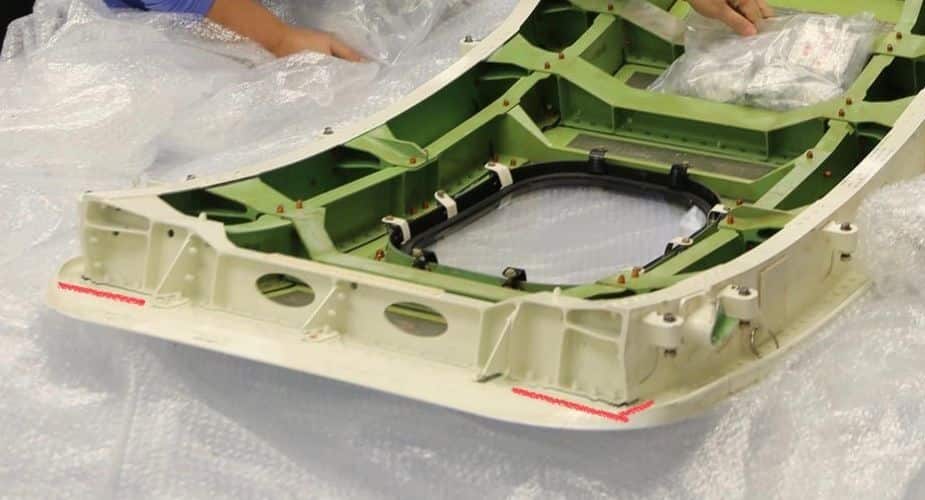
What I would love to see is a slow motion clip of both the door and plug during the inward and outward phase of closing. I imagine the top edges being very close.

Join Date: May 2011
Location: U.S.
Posts: 84
Likes: 0
Received 0 Likes
on
0 Posts
The warnings were unrelated to an actual pressurization problem. The warning was an "Auto Fail" warning with an "ALTN" annunciation light. This means there was an error in the primary pressurization controller that the alternate pressure controller did not experience, so control of the pressurization automatically switched to the alternate controller (there are two controllers that operate simultaneously with one active and and one operating as an alternate controller in a stand by mode). Every flight they automatically alternate primary and alternate roles. So in each case, the issue was resolved by the controllers automatically switching roles and throwing the warning. The NTSB has also discounted the Auto Fail being related to the loss of the plug. One more point, on the Jan 4th flight, the light came on after landing, further discrediting an actual pressurization issue.
Here is just one of the articles on the NTBS's statement on the topic: https://www.webcenterfairbanks.com/2...outputType=amp
Bottom line is the histrionics about the "warning lights" should be discounted and the "warning lights" can't be used as evidence that the WiFi installation was related to the event. It doesn't mean the WiFi installation was not related to the event, it is just that the pressurization system warnings do not support that theory.
Here is just one of the articles on the NTBS's statement on the topic: https://www.webcenterfairbanks.com/2...outputType=amp
Bottom line is the histrionics about the "warning lights" should be discounted and the "warning lights" can't be used as evidence that the WiFi installation was related to the event. It doesn't mean the WiFi installation was not related to the event, it is just that the pressurization system warnings do not support that theory.
"The NTSB will go back and look at cabin pressure data from the flight data recorder to decipher what caused the de-pressurization, as well as seek the expertise of a pressure control system specialist from Boeing."
Furthermore, your statement that "the issue was resolved by the controllers automatically switching" is demonstrably false because "the issue" returned after the first switchover. The fact that the ALTN system didn't flag tells us less than you think, especially for an intermittent problem. In fact the aircraft was restricted from ETOPS because from Alaska Airlines' perspective the issue had not been resolved. Whether or not it was correlated to the incident remains to be seen. Definitely not "histrionics" to leave it on the table at this point.
Join Date: Apr 2010
Location: Alexandria VA USA
Posts: 40
Likes: 0
Received 0 Likes
on
0 Posts
Respectfully, I think you are over-reaching with what is known. On the 8th the NTSB had not yet established a correlation and this article is just parroting the same news conference we all watched, one hour later. NTSB clearly said they are still investigating. I don't believe anybody from the investigation ruled out a correlation, they just said they had not established a correlation after 2 days of looking (at mostly other things).
Furthermore, your statement that "the issue was resolved by the controllers automatically switching" is demonstrably false because "the issue" returned after the first switchover. The fact that the ALTN system didn't flag tells us less than you think, especially for an intermittent problem. In fact the aircraft was restricted from ETOPS because from Alaska Airlines' perspective the issue had not been resolved. Whether or not it was correlated to the incident remains to be seen. Definitely not "histrionics" to leave it on the table at this point.
"The NTSB will go back and look at cabin pressure data from the flight data recorder to decipher what caused the de-pressurization, as well as seek the expertise of a pressure control system specialist from Boeing."
Furthermore, your statement that "the issue was resolved by the controllers automatically switching" is demonstrably false because "the issue" returned after the first switchover. The fact that the ALTN system didn't flag tells us less than you think, especially for an intermittent problem. In fact the aircraft was restricted from ETOPS because from Alaska Airlines' perspective the issue had not been resolved. Whether or not it was correlated to the incident remains to be seen. Definitely not "histrionics" to leave it on the table at this point.
HOMENDY: "Well, those warning lights, we - first of all, we have a team that is looking at those warning lights. At this time, we have no indication that those warning lights were in any way related to the expulsion of the door. And let me just take a second to describe that. That system monitors and adjusts cabin pressure and - automatically. There's a primary system, there's a secondary system and there's a manual system. So there are two backups on the aircraft. It's a triple redundant system. We know the two other systems were working on the aircraft, and the Federal Aviation Administration allows airlines to continue flying the aircraft with those other backup systems. So in this case, what we want - we do want to make sure there was no linkage, so we are pulling the memory cards and looking at the maintenance and testing that was done on those systems."
So they are continuing to look at pressurization data, but the system the Chairwoman is talking about is the automatic pressurization system that threw the warning. The Chairwoman describes it as triple redundant with two automatic controllers and a manual control. The failure modes associated with the warnings generated by that system when one component fails and the others are working, as described above by the Chairwoman, have nothing to do with a loss or fluctuation of cabin pressure.
Again, the way the system works is that if one controller throws an error, and the others don't, the system illuminates the AUTO FAIL light and automatically switches to the alternate system as indicated by the ALTN annunciator. So I am saying that the ALTN light was illuminated.
Alaska chose not to perform ETOPS flights, but it wasn't due to any pressurization issue. It was due to the transient pressurization controller errors.
When I say the issue was resolved, I mean the Auto Fail light illumination and loss of automatic pressurization. Failover was automatic although It seems the AUTO FAIL light was extinguished by the flight crew, in at least one case, switching the mode switch to ALTN. It didn't magically fix the pressure controller that kept throwing errors, but the warning went away for the remainder of the flight with the green ALTN annunciator remaining illuminated.
And there was much histrionics about the "pressure warning light" which was suggested by the press early on to be a pressurization issue. That has been picked up here and elsewhere and incorrectly used to claim that the plug was causing pressurization issues prior to the incident flight.
Bottom line is this, the illumination of the "warning lights" has nothing to do with failure to pressurize, loss of pressurization or fluctuation of pressure. Thats not to say there weren't pressurization issues prior to the incident, but to say the "warning lights" might indicate a plug induced pressurization issue is simply not supported by the way the system functions and the facts as we know them now.
Last edited by Old Ag; 16th Jan 2024 at 01:45.
Would not a high cabin rate of climb, due to a miss placed plug leaking cabin air cause a warning?
After some time with engine supplied air the plug might seal enough to stabilise the cabin ROC.
Though I seem to remember early versions of the B737 would pre pressurize a little prior take off to prevent a pressure bump when rotation occurred and the outflow valve receives atmospheric air flow.
I also recall, in hot conditions, a no engine air off take during take off and initial climb, all be it JT8, SOP's.
After some time with engine supplied air the plug might seal enough to stabilise the cabin ROC.
Though I seem to remember early versions of the B737 would pre pressurize a little prior take off to prevent a pressure bump when rotation occurred and the outflow valve receives atmospheric air flow.
I also recall, in hot conditions, a no engine air off take during take off and initial climb, all be it JT8, SOP's.
Join Date: Sep 2009
Location: Seattle, USA
Age: 57
Posts: 27
Likes: 0
Received 0 Likes
on
0 Posts
Also, was it considered that the aft lower hinge bracket stayed on the hinge? I have followed the thread but donít recall if that was talked about. It looks like the bracket is still on the aft hinge, comparing both the hinges (yellow arrows) front to rear, and also their shadows (red arrows).
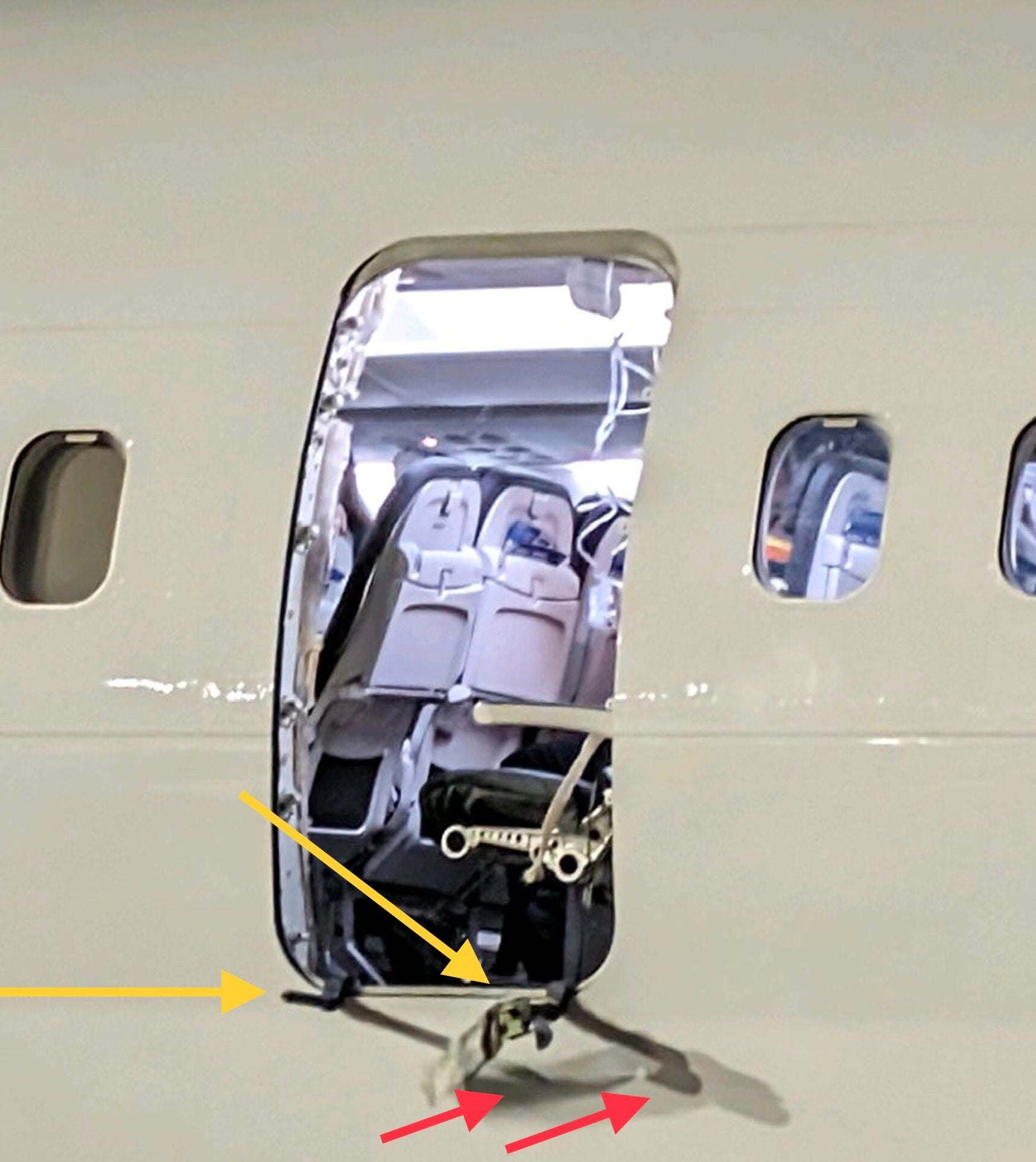
Join Date: Apr 2010
Location: Alexandria VA USA
Posts: 40
Likes: 0
Received 0 Likes
on
0 Posts
Would not a high cabin rate of climb, due to a miss placed plug leaking cabin air cause a warning?
After some time with engine supplied air the plug might seal enough to stabilise the cabin ROC.
Though I seem to remember early versions of the B737 would pre pressurize a little prior take off to prevent a pressure bump when rotation occurred and the outflow valve receives atmospheric air flow.
I also recall, in hot conditions, a no engine air off take during take off and initial climb, all be it JT8, SOP's.
After some time with engine supplied air the plug might seal enough to stabilise the cabin ROC.
Though I seem to remember early versions of the B737 would pre pressurize a little prior take off to prevent a pressure bump when rotation occurred and the outflow valve receives atmospheric air flow.
I also recall, in hot conditions, a no engine air off take during take off and initial climb, all be it JT8, SOP's.
Join Date: Feb 2004
Location: Australia
Posts: 1,307
Likes: 0
Received 0 Likes
on
0 Posts
You need to convert the 271 KIAS to TAS (use https://indoavis.co.id/main/tas.html for example) and then convert that to ft/s. I have guessed at some of the values or used standard values, but that gets me 283.75 lbf/ft^2 or 1.97 psi.
Join Date: May 2010
Location: SOF BG/EU
Age: 63
Posts: 90
Likes: 0
Received 0 Likes
on
0 Posts
Door plug not meant for N704AL
Re-examining some pictures I suddenly realised that the door plug wasn't intended to be fitted on N704AL (LN 8789), but on N705AL (LN8799), the latter delivered last December. Coincidence, normal practice? Original door plug intended for N704AL with issues, e.g. not a good fit?
Speculating now, with hindsight maybe also the second door plug wasn't the greatest fit (resulting in top door plug frame cracks?). Perhaps its the door plug batch (since similar door plugs are already in use since 2007 on the NG-900ER w/o any reported problems) or the door frame of N704AL?

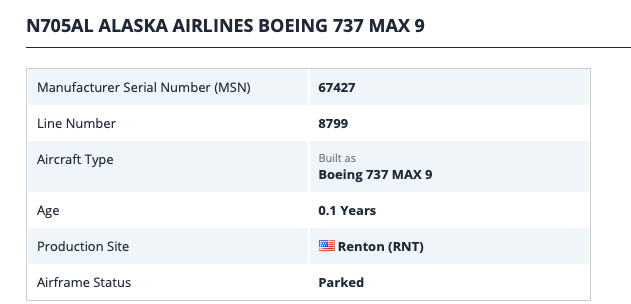
Speculating now, with hindsight maybe also the second door plug wasn't the greatest fit (resulting in top door plug frame cracks?). Perhaps its the door plug batch (since similar door plugs are already in use since 2007 on the NG-900ER w/o any reported problems) or the door frame of N704AL?


Last edited by D Bru; 16th Jan 2024 at 11:12. Reason: Adding speculation
When I say the issue was resolved, I mean the Auto Fail light illumination and loss of automatic pressurization. Failover was automatic although It seems the AUTO FAIL light was extinguished by the flight crew, in at least one case, switching the mode switch to ALTN. It didn't magically fix the pressure controller that kept throwing errors, but the warning went away for the remainder of the flight with the green ALTN annunciator remaining illuminated.
And there was much histrionics about the "pressure warning light" which was suggested by the press early on to be a pressurization issue. That has been picked up here and elsewhere and incorrectly used to claim that the plug was causing pressurization issues prior to the incident flight.
Last edited by hec7or; 16th Jan 2024 at 09:40.
Good news... courtesy of the Australian satirical website, The Shovel.
https://theshovel.com.au/2024/01/16/...h-maintenance/
Screwdrivers Now Permitted On Boeing Flights, To Allow Passengers To Help With Maintenance
"Travellers on Boeing 737 flights will be allowed to bring on-board screwdrivers, drills and any other tools deemed necessary to keep the doors from flying off, aviation authorities have confirmed."https://theshovel.com.au/2024/01/16/...h-maintenance/
Join Date: Oct 1999
Location: UK
Age: 70
Posts: 288
Likes: 0
Received 0 Likes
on
0 Posts
Re-examining some pictures I suddenly realised that the door plug wasn't intended to be fitted on N704AL (LN 8789), but on N705AL (LN8799), the latter delivered last December. Coincidence, normal practice? Original door plug intended for N704AL with issues, e.g. not a good fit?
(https://en.m.wikipedia.org/wiki/Air_Transat_Flight_236 )
where an engine part was substituted in MX - it fitted but it didn't have the same p/n - and the resulting lack of clearance chafed a fuel line resulting in a dual flame out halfway across the pond. I'm sure the auditors will confirm all this when going through the QMS at Spirit.
Last edited by Pinkman; 16th Jan 2024 at 09:08. Reason: added reference
Join Date: Mar 2022
Location: Nearby
Posts: 41
Likes: 0
Received 0 Likes
on
0 Posts
You donít have to use TAS. You can use IAS along with sea level air density, or TAS with density at altitude and get the same dynamic pressure result. Itís how an airspeed indicator works.
Join Date: May 2010
Location: SOF BG/EU
Age: 63
Posts: 90
Likes: 0
Received 0 Likes
on
0 Posts
NTSB/Boeing door plug diagram discrepancy
Surprisingly, the door plug diagram published by NTSB, sourced from Boeing (sic!), shows the two bottom spring rods in a compressed position in a door plug open situation, while the door plug remains flush with the bottom doorframe. In reality, of course, in an open door plug situation the spring rods would be flush with the top of their guide brackets attached to the door plug frame and the door plug itself would be lifted from the bottom doorframe, commensurate with the distance travelled by the spring rods.
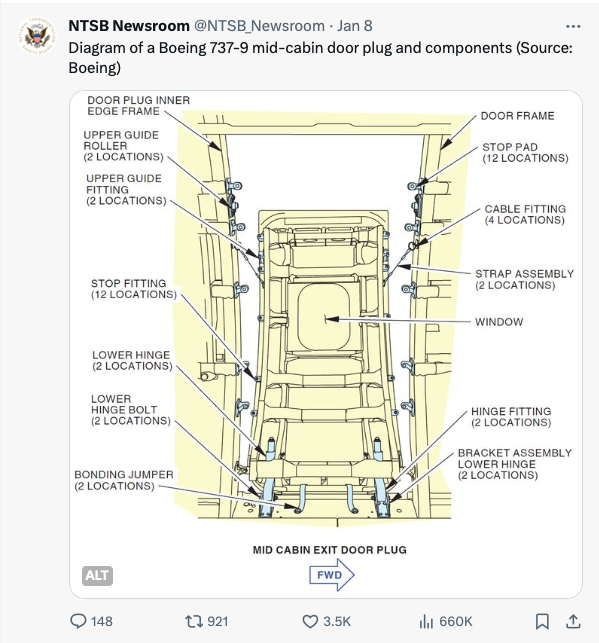
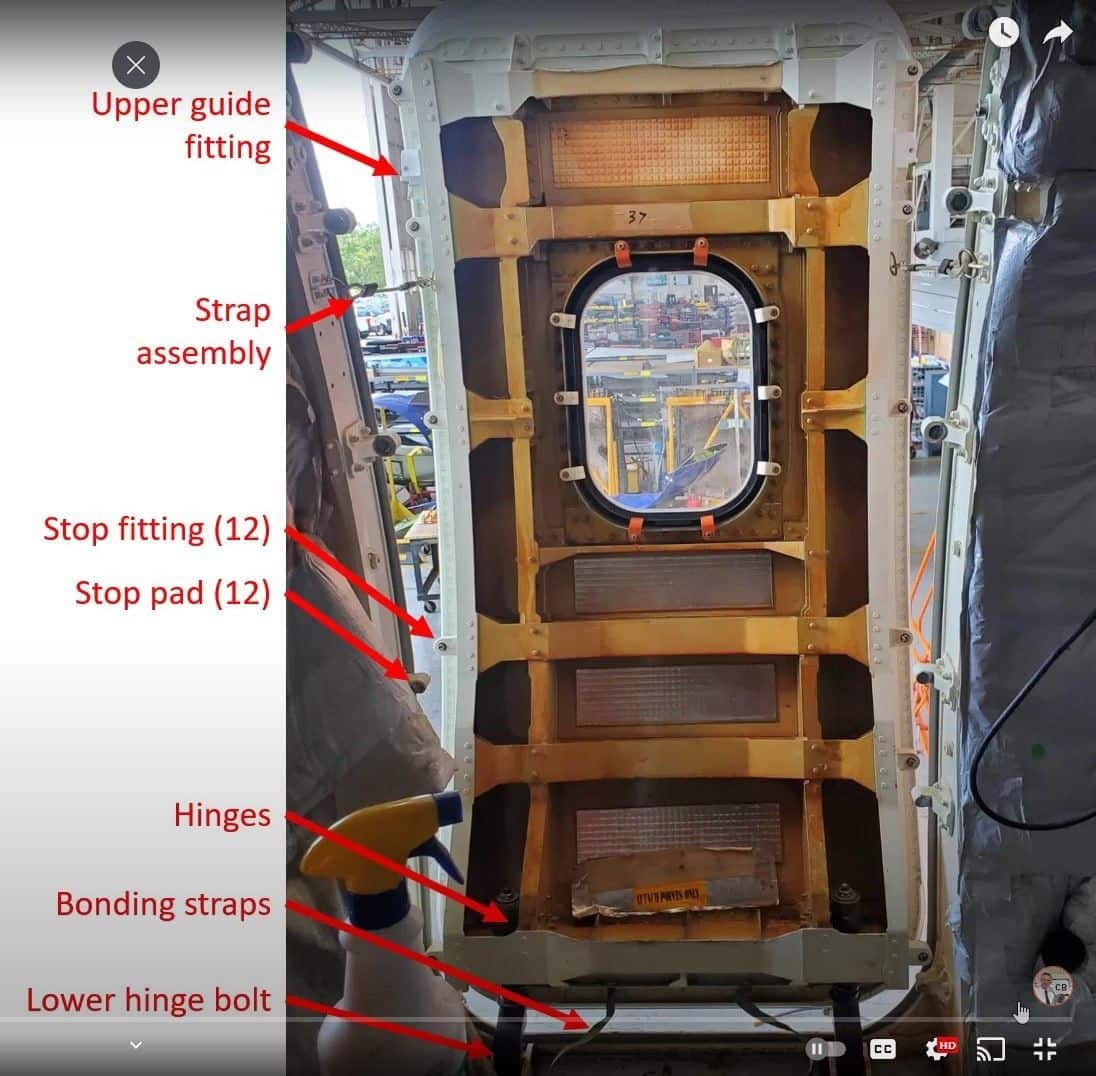


Join Date: Apr 2010
Location: Alexandria VA USA
Posts: 40
Likes: 0
Received 0 Likes
on
0 Posts
Might it be both pressure controllers experienced an uncommanded change of cabin pressure and attempted to initiate an auto transfer which failed and caused the auto fail light to illuminate



